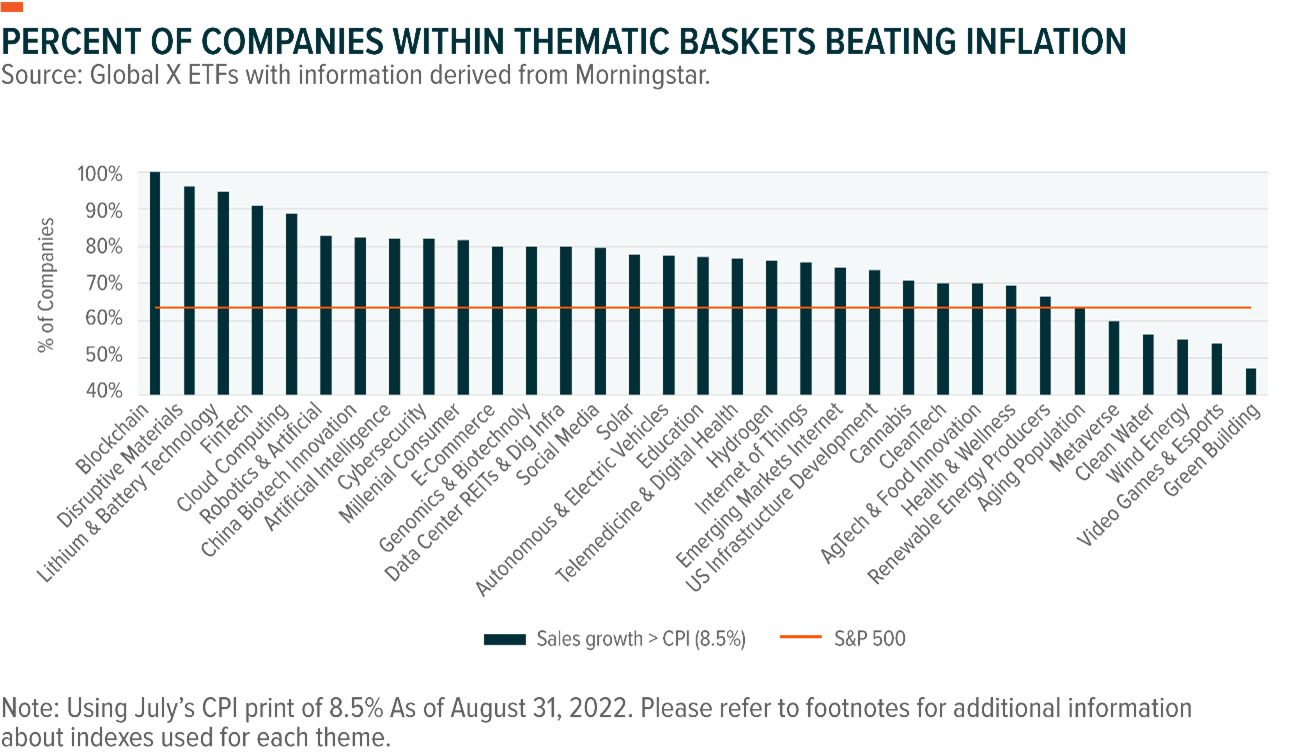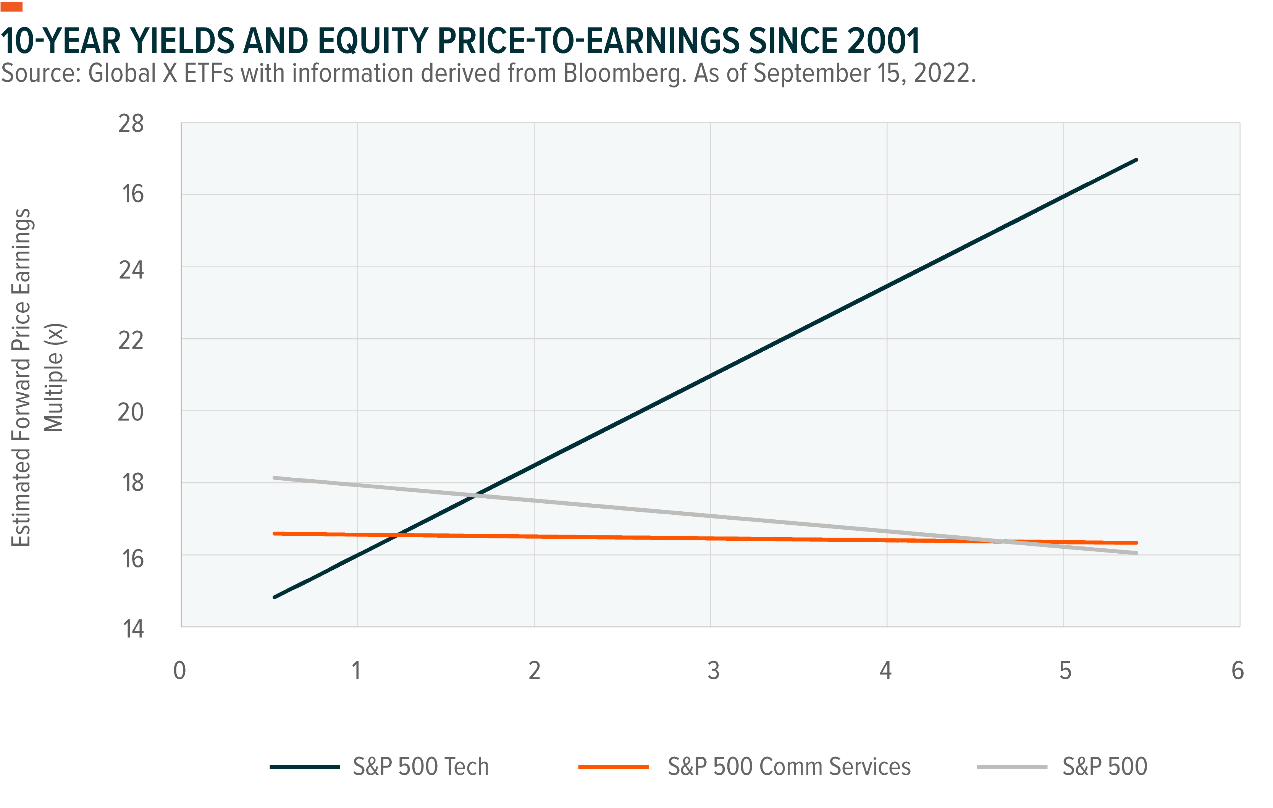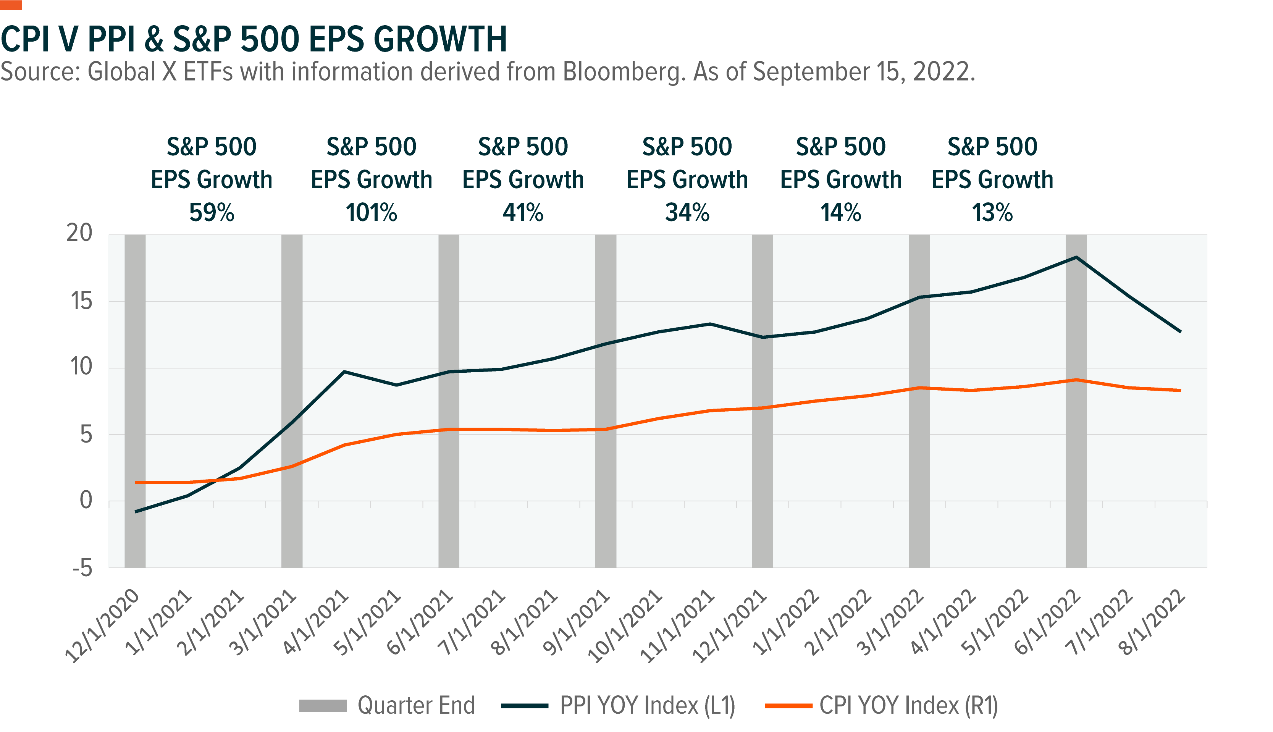Is thematic growth a crazy response to high inflation?

Global X ETFs
We consider Warren Buffett a pretty wise and successful investor. So in analyzing current investor perceptions about thematic growth, we looked at the advice he offered in a Berkshire Hathaway shareholder letter all the way back in 1981, another period of high and persistent inflation. Buffett suggested buying businesses with two characteristics: pricing power and rapid growth. Growing revenue rapidly, by either means, can provide insulation from inflationary headwinds and may even result in margin expansion.
In 2022, growth stocks have fallen out of favor with investors concerned about rising interest rates and profit margins. However, closer inspection reveals these concerns may be overdone. And if we follow Warren’s wisdom, we believe investors may want to reconsider thematic growth as a potential approach to offsetting high inflation and slowing economic growth.
Key Takeaways
- Numerous innovation-based themes grew their toplines faster than inflation over the past 12 months, and we view many of their catalysts as structural and longer-term in nature.
- Firms with low debt operate in areas with thematic growth opportunities. With the impact of recent rate increases more acute on the short end of the yield curve, we believe selloffs or revaluation of thematic growth may not be warranted.
- Producer prices diverging from consumer prices may be a key to the current earnings resilience, as companies have had time to adapt. Also, consumer inflation has dampened sentiment somewhat, but the labour market has remained strong and supported consumer spending – evidenced by firm Australian retail sales numbers even as rates have risen.
Growth Themes Continue to Deliver Robust Sales Performance
Companies in some of the most dynamic and disruptive segments of the economy continue to prove the thesis that innovation is a powerful factor driving the economy. Across US markets we continue to see sales growth performing reasonably well, with 63% of S&P 500 companies outpacing US inflation which was 8.5% in July 2022, whilst in Australia, we saw slightly less at 56% of companies beating the 7% July 2022 inflation reading.
Recent drawdowns across growth names, have left many unloved and well below the broader indices. However, of the growth themes tracked by Global X such as cybersecurity, artificial intelligence, renewable energy, and digital health, we noted an increasing number of companies with sales growth beating inflation. We saw all but one having at least 50% of the company inclusions being above US inflation prices. Plus, 26 of the 33 themes we track are outpacing the sales growth of the S&P 500.

Catalysts driving growth across themes vary, but many are tied to long-term structural changes in the economy, potentially pointing toward further growth over time. For example, lithium and battery technology firms should benefit from ambitious electric vehicle (EV) plans and the inelastic nature of supply. Increased digitisation means an increased need for protection against vulnerabilities, like we have seen with the recent Optus breach, helping to ensure strong demand for cybersecurity firms. Genomics and biotech firms, boosted by strong sales of mRNA COVID-19 vaccines, have many new treatments in development. Also, the global energy transition is likely to keep cleantech, renewable energy, and hydrogen companies in demand, especially as fossil fuel prices remain high.
Rising Rates a Shorter-Term Risk for Firms in the Growth Phase
Higher interest rates translate to higher borrowing costs for companies over the long run. Increases in the cost of capital reduce the value of future earnings. While all equities are subject to this discounting, companies with loftier expectations for earnings further out in the future are likely to be the most susceptible. Growth companies generally reinvest capital today to grow future earnings. In theory, this feature makes them sensitive to rate increases.
Companies’ cost of capital, and therefore the price of equities, should be more sensitive to long-term rates. Fluctuations in short-term rates may not warrant revaluation or selloff, especially for companies with relatively low debt levels common in the growth stage. The recent interest rates increases across developed markets are more pronounced on the short end of the yield curve as we are seeing with an inverted curve in the US, UK and many other European countries. Australia luckily is still showing a normal yield curve, but it is no secret domestic rates are rising alongside our international peers.
Growth stocks already went through significant valuation compression this year as interest rates rose. Using the Russell Growth Index as an indicator, its forward price-to-earnings multiple has already contracted from 34x to 24x this year to date. The S&P 500, by contrast, is down only 5.5x.
Since 2001, US large-cap stock valuation is inversely correlated with long rates. When interest rates rise, the price-to-forward-earnings ratio on the S&P 500 is typically lower. The higher-growth technology sector is an exception, as the multiple has increased with rates over that time. Further, there is no meaningful historical relationship between the 10-year rate and the communications sector, which includes growth segments like social media and streaming companies.

Profitability Questions Loom, But Price Dynamics, Labour Market Keeping Earnings Resilient
Some pundits argue significant downward revisions to corporate profit estimates through the end of the year are warranted as companies face higher costs from labour and inputs at a time when demand may weaken. However, earnings expectations for the S&P 500 and S&P/ASX200, have remained stable this year with 2023 and 2024 seeing earnings expectations continuing to grow.
An interesting angle where we see a possible clue to earnings resilience may be found in the divergence between producer prices and consumer prices. Consumers first saw prices rise 7% year-over-year (YoY) in December 2021. But companies saw that type of price increase a full eight months earlier in April 2021. Consumer price increases peaked at 9.1% in June 2022, versus producer prices peaking at 18.3% in June 2022. The difference between the two reached a 70-year high.
Despite the faster rise in producer prices, US companies continue to generate profit growth YoY. To be sure, a slower rate of price increases for companies would be preferred, but firms seem to have found ways of navigating through the higher-cost environment – likely through greater operational discipline and improved technology deployment. One common cost control tool, downsizing, has not come into play yet, as unemployment rates stay robust across the US, Australia, and other developed nations.
The labour market, and its effects on the health of consumers, may be the biggest potential headwind. If unemployment were to rise rapidly and consumer spending contracted as a result, we know that may have further negative implications for equities broadly.

Conclusion: Thematic Growth Can Offer Short- and Long-Term Protections
It is understandable why investors are skittish of assets seemingly vulnerable to this high inflation, rising rate environment. However, in markets like these, it’s often best to eliminate as many variables as possible and simplify investment decisions. In Global X’s view, Buffett’s message in 1981 offers a guide. Pricing power and rapid growth can be keys to coping with high inflation. They are also common traits of thematic growth equities. And through them, we believe investors can find rapidly growing revenue that helps protect against inflation along with opportunities to capture innovation tied to longer-term structural shifts in the global economy.
Beyond Ordinary ETFs
For more than a decade, our mission has been empowering investors with unexplored and intelligent solutions
To learn more about what Global X ETFs can do for your portfolio please visit our website.
3 topics

Blair Hannon joined Global X ETFs as Head of Investment Strategy in March 2022. He is responsible for supporting the development of the firm’s Australian ETF business by working closely with the research, marketing, and sales team to produce...
Expertise

Blair Hannon joined Global X ETFs as Head of Investment Strategy in March 2022. He is responsible for supporting the development of the firm’s Australian ETF business by working closely with the research, marketing, and sales team to produce...
